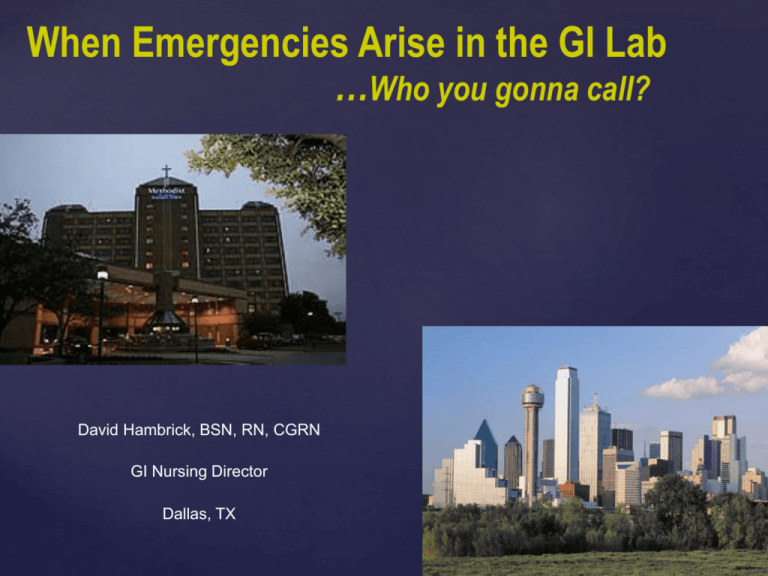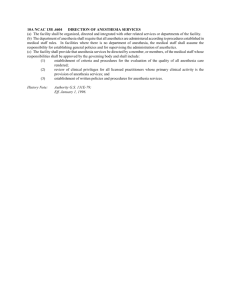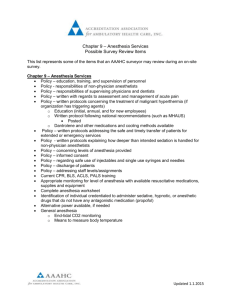Measuring Endoscopy Lab Efficiency
advertisement

When Emergencies Arise in the GI Lab …Who you gonna call? David Hambrick, BSN, RN, CGRN GI Nursing Director Dallas, TX Objectives 1) Describe potential GI patient specific emergent situations 2) Describe adequate preparation and response techniques for GI patient-specific emergent situations 2 What Admin & patients think GI staff look like 3 What we really feel like 4 Emergencies in #MyGILab? It’s more common than one would think Emergencies are not confined to just the procedure room, often occur during off-unit procedures Regardless of setting, emergencies can happen throughout the peri-procedural continuum Occur in hospital & ASC based units What is a GI Endoscopy Emergency? Definition depends on several factors… Overall patient presentation Significant co-morbidities Intra-procedural complications Presence of Specialists incl Anesthesia Also depends on: Who you ask (Internist, GI, Surgeon) Time of Day, Day of week, Discharge status Availability of physician, their clinic/office time and/or a 0700 open room tomorrow morning 6 Our Definition of Patient Emergency “An unexpected situation requiring an immediate response in order to prevent or minimize undesirable patient complication or outcome” D Hambrick, 2015 Bleeding, Hypo/hyper tension Malignant hypertension (est 0.00001% GA cases) Equipment malfunction Worsening patient condition despite intervention May also include: Facility related issues (power loss, fire, etc) Staffing availability Internal/external disaster scenario 7 Disclaimer time This presentation is to review unit preparation for Emergencies, not clarification of the definition Each facility’s Medical Staff/GI Lab Committee has to set up expectations for: Response time for emergencies Patient conditions requiring emergency intervention Who responds to emergency procedures (anesthesia) Quality/Performance metrics associated with utilization of on-call/after hours atff 8 Most Common (Clinical) GI Emergencies Acute Abdominal Pain Gastrointestinal Hemorrhage Biliary Tract Obstruction Hepatic Failure (Variceal Bleed) 9 The GI Lab is Everywhere Ideally, emergent procedures are handled in the GI Lab, M-F, 0700-1500, but… Emergency Room Intensive Care Unit Operating Room “The Floor” 10 Leadership Responsibilities Scope of practice review to determine potential emergent procedures Staff competencies and practices must be reviewed to identify potential failure points Coordination with ancillary Leadership and staff for expectations of emergency response Anesthesia, Radiology, ICU, ED, Periop, Lab, Blood Bank, etc 11 Okay, so what does that mean to us? All staff responding to GI emergencies must be competent in the expected treatment modalities Different depending on practice settings ASC vs Community vs Academic All staff performing a role in emergent GI procedures must be trained to standard/competency with regular re-validation or demonstration All equipment required for scope of intervention must be available & servicable 24/7 12 The Safest Way to Do Anything… Standardize the Process All unscheduled/urgent/emergent procedures should be handled the same way Starting with notification of the GI Lab staff, have one way to do it, regardless of day, time, procedure Have a standardized report form, including Pt ID (two identifiers, name DOB) Pt location Procedure to be performed Location of procedure (ICU, ED, GI Lab, etc) Expected time of procedure Other services needed (Anesthesia, blood bank, pathology, etc) Let’s Do It Right the First Time Benefits of standardizing the process: Eliminate problems with mis-communication, direct calls to staff from physicians to nursing/tech staff Education of physicians, Fellows, Nursing/Tech staff conducted, documented, part of Orientation Ensures equipment, devices, etc are present and available for use Ensures trained & competent staff present Process should go through Governance process, accepted by GI Lab Committee to ensure compliance What Could Possibly Go Wrong? Usual scenario: It’s 0115 on Tuesday night, the GI Fellow calls the cell phone of GI Tech/Nurse on call: “We need to do an EGD, patient is in the ED waiting on an ICU bed. GI bleed, need to do it ASAP, let the on call nurse & anesthesia know, thanks <click>” Recipe for Disaster… The GI staff now has to figure out: Name, location of patient, where the patient will be when they arrive What type of GI Bleed? Variceal? Foreign body damage? Hematemesis? Gastric? Rectal bleed but r/o upper GI cause? Post-surgical? What equipment is needed? Is anesthesia available? Have they been notified? Are they necessary? The Staff tries to figure it out… So, they: Call other on-call staff, give general patient info Go to hospital, grab everything based on personal experience Spend 30 minutes tracking down where the patient is, find out that Anesthesia wasn’t notified Go to patient location, start procedure, realize you don’t have what is needed, case is delayed while running back to the GI Lab to find it Meanwhile: The patient care is delayed Physician is frustrated Everybody gets yelled at the next morning 17 Replay using Standardized Process The physician notifies the hospital operator to page the on-call staff, creating a log entry to review in case of performance variances On-call staff responds to page, calls physician to get patient and procedure information Using standardized report format, receives all pertinent information including: Pt ID (two identifiers, name & DOB) Pt location Procedure(s) to be performed & special equipment needed Location of procedure (ICU, ED, GI Lab, etc) Expected time of procedure Other services needed (Anesthesia, blood bank, pathology, etc) 18 Once the Team is on site… All team members meet at the agreed upon procedure location All requested or expected equipment is present All ancillary staff is prepared per protocol Staff demonstrates competency in equipment and device set-up and use Procedure is performed, optimal patient care is delivered Nobody is yelled at the next morning 19 How to Standardize the Process Recognize the Need Recognize the Need Recognize the need How do we do that? Present objective data to GI Governance team to demonstrate change is required to improve patient care, outcomes, physician, patient, staff satisfaction Identify shortcomings in staff education and procedural competencies using: Formal competency evaluations Feedback from staff, physicians Data elements from scheduling and procedure reporting software 21 Then what? Develop standardized exectations for each role Use task specific training plans based on identified shortcomings for all roles Use standardized Best Practice training & processes to minimize staff performance variances Using (unit experts, vendor clinical experts) train staff to competency, documenting competency in employee files Establish feedback mechanisms between staff, physicians and leadership (GI Lab Committee) on improvement processes and outcomes 22 Let’s wrap it up There’s one standard of performance to competency regardless of time, location or duration or procedure All team members are to be trained to competency and then required to perform to that standard Variances in the process are identified, trended, and corrective action taken as required Expecting untrained, incompetent staff to perform to standard is harmful to patient outcomes as well as staff and team development and cohesiveness 23 Questions?






